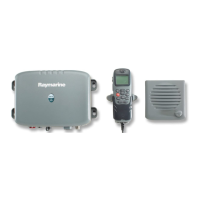
Do you have a question about the Raymarine RAY 240 and is the answer not in the manual?
Overview of the processor board's role as the central control unit and its functions.
Details on 12V battery supply, protection, filtering, and voltage regulation for the system.
Information on the MC9S12DG128CPV microcontroller, its memory, and peripherals.
Description of signals controlling the radio module: analogue inputs, SPI data, and DC voltage trims.
Explains audio signal routing between system components and audio amplifier functions.
Details on how DSC and ATIS signals are encoded, processed, and transmitted.
Covers line-level audio, serial comms, PTT, and mute signals for handset communication.
Describes serial communication via Seatalk and NMEA0183 for external systems like GPS.
Information about the provision for an NMEA2000 compliant 'Seatalk2' interface.
Details on operating the loudhailer in 'talk' or 'listen' modes and as a fog horn.
Describes the optional plug-in board for connecting to a standard telephone line.
Specifies power consumption in Rx and Tx modes, and supply voltage requirements.
Details frequency range, output power, and modulation characteristics of the transmitter.
Covers receiver frequency range, sensitivity, and IF stages for channel selection.
Explains the phase-locked loop synthesiser and its role in frequency control for Tx and Rx.
Describes the PIN diode switch and low-pass filter for antenna signal management.
Details the function of bandpass filters and Low Noise Amplifiers in receiver signal conditioning.
Explains the mixer's role in down-converting received signals to the IF frequency.
Describes crystal filters for attenuating image frequencies and adjacent channels.
Details the Detector IC's role in down-converting and demodulating the received audio signal.
Details power supply range, voltage regulation, and protection mechanisms for the handset.
Information on the Texas Instruments MSP430F135 microcontroller and its functions.
Description of the 128x64 pixel graphic monochrome FSTN LCD display module.
Details the 27 pushbuttons, including dedicated DISTRESS and PTT keys.
Describes the Seatalk interface used for communication with the main processor.
Details the control of display, keypad, and distress button backlighting via PWM.
Explains the 2-stage pre-amplifier circuit with automatic level control.
Details the Philips TDA8552 amplifier, volume control, and speaker output.
Describes the key-beep facility and its dependence on the volume control setting.
Explains the hall effect sensor used to detect if the handset is in its cradle.
Details how the distress button sends DSC distress messages, monitored directly by the processor.
Describes the PTT line's role in setting transmit mode and initial setup communications.
Details power supply range, thermal protection, and short circuit protection for the amplifier.
Description of the Philips 8943SF amplifier, its modes, and output power.
Explains the mute signal's operation and how it is overridden by volume or alarm.
Details how alarm conditions override mute and volume settings for DSC distress calls.